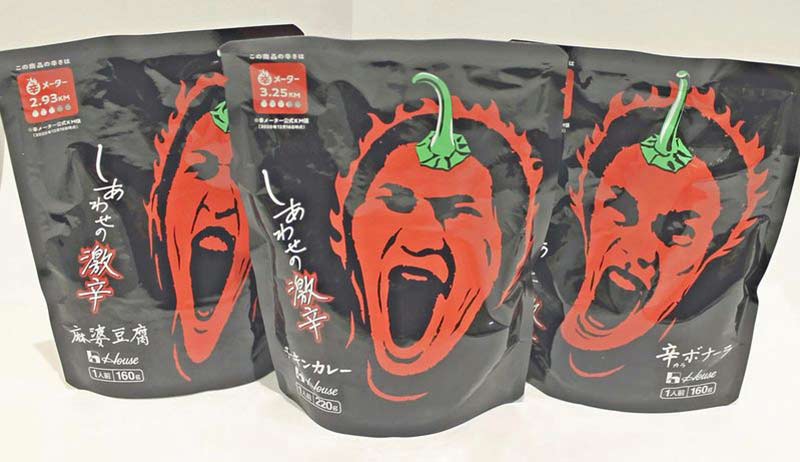
House Foods Corp.’s series of hot and spicy food products called Shiawase no Gekikara
November 30, 2021
Variety may be the spice of life, but how zesty should it be? Judging from consumer sentiments, some like it sizzling as red-hot foods are selling well in the so-called fourth boom of gekikara, which translates as extremely spicy.
Bars and restaurants were in the vanguard during previous gekikara booms, but with everyone cooped up because of the coronavirus, super-spicy foods that can be enjoyed at home are becoming increasingly popular.
For some, blazing-hot foods are a simple stimulus that helps relieve stress.
In April, House Foods Corp. launched a series of hot and spicy food products dubbed Shiawase no Gekikara (the happiness of super spiciness) exclusively on the internet. The products have proved popular, topping the list of a major online shopping site’s rankings. Dishes include curry in ready-made packaging, mapo tofu and spicy carbonara pasta sauce, which was developed after a gekikara food fan said a peppery sauce poured over a white sauce tastes great.

S&B Foods Inc.’s Moekara Togarashi
All of the products are hotter than the company’s standard five levels of spiciness set for curries and other piquant foods.
“The series is popular not only among gekikara lovers, but also among people who occasionally want to enjoy really spicy food,” a company official said.
In a survey conducted by Recruit Lifestyle’s Hot Pepper Gourmet Gaishoku Soken research institute regarding gekikara foods, 44% of respondents who liked very spicy food said they sought out stimulation via gekikara products because they have been going out less during the pandemic. The institute queried 1,107 people in their 20s to 50s nationwide in April and May.
According to the survey, 32% of those who originally did not like such food came to enjoy spicy dishes.
The institute’s senior researcher Mari Ariki said extremely spicy foods have become a stress reliever amid the pandemic.
According to Ariki, the first boom occurred in the 1980s when Koikeya Co.’s Karamucho hot-chili potato chips debuted and gekikara became a buzzword.
The second boom happened when Korean food got hot around 2000. The third boom sprouted in the early 2010s when a wider range of chili peppers, such as habanero, aroused the public’s palate.
In this fourth one, which started in 2018, the hua jiao Sichuan pepper caught on. The spice is indispensable for Sichuan cuisine, which is among the so-called shibire-kei, or electrifying spicy dishes.
The current boom is characterized by even spicier foods. Fresh spices such as green chili peppers and domestic ingredients including yuzu kosho citrus and chili paste are attracting attention.
Lawson Inc.’s Spicy Karaage-kun Red chicken nuggets, which sell for ¥216, were the top-selling item in September via the company’s delivery service that is being introduced at about 2,200 stores. Lawson said the product’s popularity coincides with demand for alcoholic drinks being consumed at home.
More seasonings for home cooking are available, too.
S&B Foods Inc.’s Moekara Togarashi spice mix, priced at ¥324, can be sprinkled over food to add some heat.
Thanks to what the company calls “fiery” spiciness, created by blending jalapeno, habanero and three other kinds of chili peppers, the spice mix has become popular. Sales jumped 50% in the year from April 2020, compared to the previous year, according to research firm Intage Inc.
S&B Foods posts recipes on its website, including one for moekara fried chicken that calls for the spice mix to be added to the batter.
Kenichi Matsushima, an associate professor at Shinshu University who is an expert on the spicy flavors of chili peppers and others, said the public has been increasingly accepting spicy foods as the booms keep recurring.
Matsushima believes the emergence of seriously spicy foods that are difficult to eat reflects such sentiments.
“Eating incredibly spicy food gives you a sense of accomplishment and makes you want to try more,” Matsushima said. “Find the balance of spiciness and deliciousness you like best.”
"Features" POPULAR ARTICLE
-

Sanrio to Open Museum in Yamanashi Pref. Dedicated to Founder, Exhibits Include Hello Kitty, Other Characters
-

Autumn Foliage Surrounds Visitors to Tokyo’s Showa Kinen Park
-

My Daughter No Longer Speaks to Me, But I Want to See Her and My Grandchild
-

Kumamoto: Public Bath Refurbished as Library Where You Can Chat, Take Photos
-

Frozen Vegetables: Demand Rises for Convenient, Tasty Domestic Produce
JN ACCESS RANKING
-

Tokyo Economic Security Forum to Hold Inaugural Meeting Amid Tense Global Environment
-

Keidanren Chairman Yoshinobu Tsutsui Visits Kashiwazaki-Kariwa Nuclear Power Plant; Inspects New Emergency Safety System
-

Imports of Rare Earths from China Facing Delays, May Be Caused by Deterioration of Japan-China Relations
-

University of Tokyo Professor Discusses Japanese Economic Security in Interview Ahead of Forum
-

Japan Pulls out of Vietnam Nuclear Project, Complicating Hanoi’s Power Plans


























